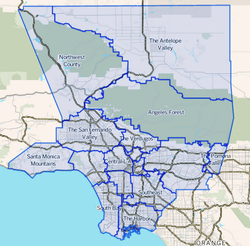Mapping L.A.
Mapping L.A. is a project of the Los Angeles Times, beginning in 2009, to draw boundary lines for 158 cities and unincorporated places within Los Angeles County, California. It identified 114 neighborhoods within the City of Los Angeles and 42 unincorporated areas where the statistics were merged with those of adjacent cities.[1]

History
The project began in February 2009 with the posting online of the first version of boundary lines for eighty-seven Los Angeles city neighborhoods. The map was then "redrawn with the help of readers who agreed or disagreed with our initial boundaries." The Times said: "After reviewing this collective knowledge, Times staffers adjusted more than 100 boundaries, eliminated some names and added others."[1]
Sources
The Times' database editor and the map project’s coordinator, Doug Smith,[2] along with researcher Maloy Moore, standardized the neighborhood boundaries "based on historical and anecdotal definitions, civic proclamations and reader commentary." "Thousands of city blocks" were converted "into a complete picture of Los Angeles neighborhoods, with no ambiguities, overlaps or missing pieces."[3]
Scope
The Times said that the Mapping L.A. project became the newspaper's "resource for neighborhood boundaries, demographics, crime and schools." The results as posted are searchable by address and ZIP code or by individual neighborhood.[1] It noted that:
The maps cover the 4,000 square miles of Los Angeles County — by far the most populous county in the nation — from the high desert to the coast. In 2009, there were an estimated 9.8 million residents, up from 9.5 million counted in the 2000 U.S. census, the basis for The Times' demographic analysis for each neighborhood and region. Unlike most other attempts at mapping L.A., this one follows a set of principles intended to make it visually and statistically coherent. It gathers every block of the city into reasonably compact areas leaving no enclaves, gaps, overhangs or ambiguities.[1]
In the project, neighborhoods are generally defined by merging together neighboring census tracts; however, census tract boundaries are not always consistent with traditional neighborhood boundaries.[4] As the Times states:
Census tracts are drawn by the U.S. Census Bureau and used for tabulating demographic information, including income and ethnicity. The shapes of the tracts are frequently out of sync with the geographical, historic and socioeconomic associations that define communities. However, by using the tracts as building blocks, The Times was able to compile a statistical profile of communities, something other neighborhood boundaries do not offer.[4]
Limitations
In 2017, cartographer Eric Brightwell of Pendersleigh and Sons [5], created a map [6] that identified 472 neighborhoods (in comparison to Mapping LA's 114 neighborhoods).
Comparing Brightwell's map with the Mapping LA Project, Elizabeth Fuller wrote in the LarchmontBuzz [7] that "Many people who live in and represent their neighborhoods in various ways have objected to the Times’ designations for not following city-recognized borders, and for lumping many smaller neighborhoods into larger, more indistinct areas such as “Mid-Wilshire.” She said that Brightwell's map was a much more fine-grained view of “every L.A. neighborhood.”
Jenna Chandler, the editor of Curbed Los Angeles, wrote that Brightwell's map of 472 neighborhoods "looks more accurate than the neighborhood maps compiled by the Los Angeles Times."[8]
LAist reporter Tim Loc said that while Mapping L.A. provided "plenty of insightful information about individual neighborhoods...Brightwell takes it to the next level when it comes to breaking down the territories." Of Brightwell's map, Loc noted that Downtown L.A. is parsed out as the Historic Core, Bunker Hill, Skid Row, and Gallery Row among others. Brightwell notes that in the Mapping L.A. Project, Downtown L.A. is just "downtown L.A. and Chinatown; there's no Jewelry District or any of the others." [9]
Categories
The website provides the following categories, among others:
- Age, median
- Age, percentage 10 and younger
- Age, percentage 11 to 18
- Age, percentage 19 to 34
- Age, percentage 65 and older
- Education, less than high-school diploma
- Education, four-year degree
- Education, master's degree or higher
- Ethnic diversity
- Foreign born
- Household size
- Income, median
- Income, $20,000 a year or lower
- Income, $125,000 a year or higher
- Percentage of Asian people
- Percentage of black people
- Percentage of Latino people
- Percentage of white people
- Population density
- Schools
- Single parents
- Veterans, percentage of
References
- "Neighborhoods," Mapping L.A., Los Angeles Times
- "L.A. Neighborhoods, You're On the Map," Los Angeles Times, February 19, 2009
- A multicolored, printable map of the 114 neighborhoods in the city of Los Angeles, produced by the Los Angeles Times.
- About Mapping L.A.
- Kathleen Miles, "Map Of Los Angeles: Eric Brightwell Of Pendersleigh & Sons Cartography, Uncovers The Real LA" March 2, 2012
- Eric Brightwell, "Los Angeles County Communities and Neighborhoods"
- Elizabeth Fuller, "LarchmontBuzz" July 29, 2017
- Jenna Chandler, "Which LA. Neighborhood Do You Really Live In?" December 27, 2019
- "Tim Loc, "Check Out This Amazing Map That Features Every L.A. Neighborhood," LAist, July 27, 2017". Archived from the original on December 2, 2019. Retrieved March 3, 2020.